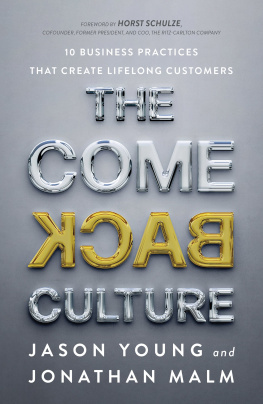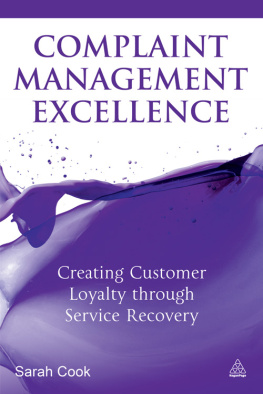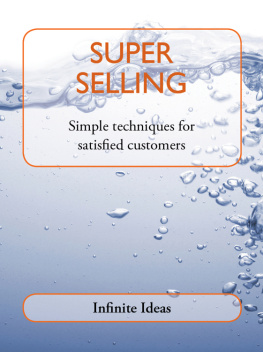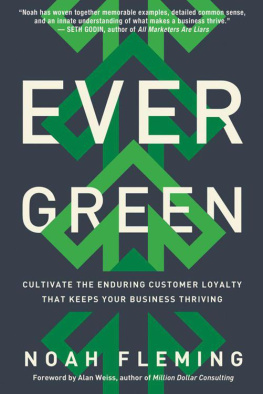Capturing Loyalty
Capturing Loyalty
How to Measure, Generate, and Profit from Highly Satisfied Customers
John A. Larson and Bennett E. McClellan
Foreword by Maxine Clark
Copyright 2017 by John A. Larson and Bennett E. McClellan
All rights reserved. No part of this publication may be reproduced, stored in a retrieval system, or transmitted, in any form or by any means, electronic, mechanical, photocopying, recording, or otherwise, except for the inclusion of brief quotations in a review, without prior permission in writing from the publisher.
Library of Congress Cataloging-in-Publication Data
Names: Larson, John A., 1947 author. | McClellan, Bennett E., author.
Title: Capturing loyalty : how to measure, generate, and profit from highly satisfied customers / John A. Larson and Bennett E. McClellan ; foreword by Maxine Clark.
Description: Santa Barbara, California : Praeger, [2017] | Includes bibliographical references and index.
Identifiers: LCCN 2017023424 (print) | LCCN 2017037556 (ebook) | ISBN 9781440856570 (ebook) | ISBN 9781440856563 (alk. paper)
Subjects: LCSH: Consumer satisfaction. | Customer loyalty. | Customer relations.
Classification: LCC HF5415.335 (ebook) | LCC HF5415.335 .L37 2017 (print) | DDC 658.8/12dc23
LC record available at https://lccn.loc.gov/2017023424
ISBN: 978-1-4408-5656-3
EISBN: 978-1-4408-5657-0
21 20 19 18 17 1 2 3 4 5
This book is also available as an eBook.
Praeger
An Imprint of ABC-CLIO, LLC
ABC-CLIO, LLC
130 Cremona Drive, P.O. Box 1911
Santa Barbara, California 93116-1911
www.abc-clio.com
This book is printed on acid-free paper 
Manufactured in the United States of America
To Maxine Clark and Horst Schultze: I have learned much from the two of you and for that I will be eternally grateful. JAL
To Earl Sasser from whom both authors have learned the value of asking the question, But why? BEM
Contents
by Maxine Clark
Believe it or not, if you ask people what they want they will generally tell you. And often in fairly plain terms. The trick is to ask the right people.
In 1997, I took my friends daughter on a shopping trip to a local toy store in search of the latest Beanie Babies, which were a craze at the time. When we could not find the one we wanted, Katie suggested they were so easy, we could make them ourselves. It was a great, flashing lightbulb moment for meof course children, properly guided, could make their own stuffed animals, and I wagered they would love them more for the experience. This flash of insight, that I could create both a product and an experience, led me to found Build-A-Bear Workshop. Our first store opened just nine months later. The idea proved popular, and we soon went from one store in St. Louis in 1997 to more than 400 in the United States and abroad.
Success brings its own challenges, though, and we encountered growing pains in our expansion from a single store to a broad retail networkthere are informalities you can get away with running a single store in your hometown that can easily turn into an Achilles heel for a larger organization, especially when the experience of making the stuffed animal is equal to the value of the stuffed animal itself! Early in our growth, in 1998 to be exact, I was introduced to John Larson by one of my initial investors, who thought he could help us codify the elements of a satisfying Build-A-Bear Workshop customer experience in a way we could roll out from coast to coast. With Johns help we were able to expand across the country and overseas with the confidence that that we could consistently deliver a great experience to our customers, be it in St. Louis or St. Charles, Portland, Oregon or Portland, Maine.
Build-A-Bear Workshop has brought smiles and happiness to millions of children, and countless parents, grandparents, and guardians around the world. But it all started with that casual conversation with my neighbors child, by listening to a model customer. I couldve listened to a slick marketer. I couldve listened to a hip trend-spotter. I couldve listened to my accountant, hairdresser, or clergyman. Im glad I listened to the right person.
In business it is absolutely critical to listen to your customers, yet it is a very subtle science to discern whom to listen to. One of the most important things I learned through my work with John is that it is a futile ambition to address every concern of every patron, client, and customer who walks through your doors, dials your phone, or darkens your inbox. It is just physically, logistically, emotionally, and intellectually impossible to take everyone into account and be all things to all people. The need to direct attention on some subset of the customer world has traditionally led customer service and loyalty initiatives to focus on greasing squeaky wheels. Dissatisfied, complaining, vocally upset customers consume a disproportionate amount of your attention bandwidth, and they demand the most effort to placate. But if you expend all your effort tending to every squeak you hear you will end up with something so greasy it is liable to slip right through your fingers. In my professional experience with John and now in this collaboration with Bennett McClellan I have gained insights into whom in your customer base you should focus your attentions that are at once both counter-intuitive and eminently sensible.
Creating and increasing customer loyalty may have been nice to haves ten years ago, but they have quickly become got to haves in the current economic environment. From 1950 to 1970 real GDP in the United States grew at 3.7 percent per year. From 1970 to 1990 it grew at 3.2 percent per yearin spite of two significant oil price shocks. Now, in the years since 2008, GDP is growing at 1.8 percent per yearhalf of the 19501970 rate. The rising tide that kept our fathers in business has turned.
Declining growth rates mean that there are not enough new customers to bail you out if you cannot keep the ones you currently have. In addition, there are more competitors than ever before trying to attract these customers, both at home, online, and abroad. Henry Ford never had to worry about Honda, and a Mercedes was a novelty that would have turned his head. There are also better sources of information available to consumers about how companies and service providers treat their customers. In the past, a poor movie was guaranteed at least one weekend of good sales before the word got out. Now, with the advent of social media, a single screening can kill a mediocre film.
Taken together, the implication of these trends is clear. Those companies that are unable to retain their current customers (and maintain or increase their current share of spend) will encounter difficult times over the next ten years. This is the new normal, and youd better have a plan. Customer loyalty is not a perkits the ante that buys you time at the table.
Which brings me to the point that I would like to stress, and to what I take to be the most profound message of this book. Customer satisfaction is not a sideline project. It is not a task to be undertaken at regular, specified intervals and forgotten in between. Regular visits to the doctor do not make a healthy person. A healthy lifestyle makes a healthy person. And if you are planning on tackling the satisfaction challenge in a similarly rote manner, this book may not be for you. If you do not plan on incorporating the customer satisfaction initiative into every fiber of your companys beingand more importantly if you are unwilling to make the investment in capital, resources, and opportunity that a successful initiative demandsthen your ends will be better served by putting this book down, going back to your office, and looking for ways to cut costs. Fire your longer-service employees and replace them with cheaper, younger hires. Shut down your customer service operation and move it to some foreign country. If, however, you are haunted by the notion that your customer franchise is not as healthy as it could be, and if you are ready to make some serious lifestyle changes, this book will have a tremendous effect on the way you do business.










